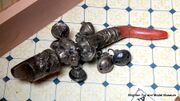Baby rattle and pacifier in silver and coral (C18th)
| Star Exhibit |
|---|
Baby rattle and pacifier in silver and coral (C18th) |
 |
| location: |
| Arch Two , Area 12 The Dolls House (display) |
| Shelf 1 |
A Georgian silver and coral baby's rattle, whistle and pacifier, incorporating a whistle, a red coral pacifier, and a set of bells.
This is currently the oldest toy in the museum.
Materials
In a world before plastics, coral was a brightly-coloured material that lent itself to whittling, and silver and gold could be worked to produce lightweight shells that didn't rust away when exposed to baby drool (although silver is very prone to tarnishing, as can be seen in our example).
Since a child would probably only ever have one of these rattles, this sort of item would have been a useful choice of christening gift, from someone with money wanting to make a statement about their commitment to a family (such as the child's godparent).
Design
This basic design of rattle, with a coral pacifier at one and, a whistle at the other, and a set of bells attached to the middle, was in production by various makers for over a century. This complicates dating unless one knows the maker. Luckily, the fact that the pieces wee made from silver (or occasionally gold) means that many carry some sort of maker's stamp.
Hygiene
To modern eyes, an ornate metal object full of crevices that could collect dirt and act as a breeding ground for germs would be an appalling thing to give to a baby, especially if it was being encouraged to put one end of the toy into its mouth.
The Victorian era was noted for its horrifically high infant mortality, part of which can be blamed on the introduction of the mass-produced baby bottle, combined with an almost total lack of basic knowledge about what really caused diseases – the "germ theory" of disease promoted by Louis Pasteur and Robert Koch only really began to gain popular acceptance in around the ~1850s, and before this is tended to be believed that many diseases were brought on by a "miasma" - essentially some sort of bad-smelling substance in the air. In reality, the bad smell that was associated with disease was usually a byproduct of the bacteria or other microorganisms that caused the disease, or that lived on decaying material alongside other disease-causing microorganisms.
Although these rattles could probably be sterilised by boiling without damaging them, owners would not necessarily have known that this was a good idea. On the plus side, the process of cleaning the silver to remove tarnish might have tended to also remove bacteria (silver can be cleaned by placing in boiling water with chemicals), and silver also has incidental antibacterial properties, so perhaps the silver rattles might have been less dangerous than the more expensive gold versions, which wouldn't have tarnished and wouldn't have needed as much cleaning to keep them looking nice.
External links
- Rattle, unknown maker, ~1750, V&A Museum (collections.vam.ac.uk)
- Child's rattle and teether, G.U., ~1835-36 (metmuseum.org)
- A very similar rattle from the early C19th, ~1832-1845 (silvercollection.it)



